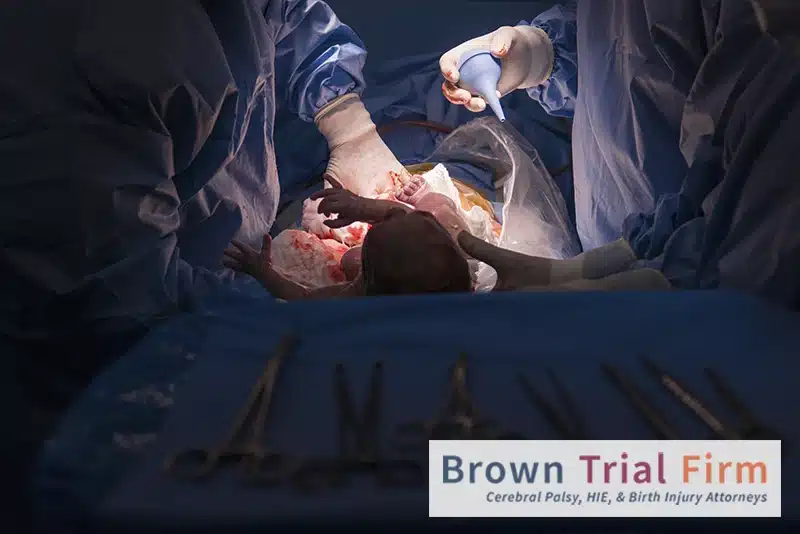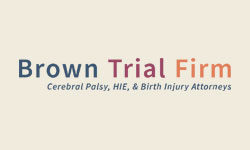Understand the causes and treatment options for Klumpke’s paralysis and when your child might be entitled to compensation
Klumpke’s palsy, also known as Klumpke’s paralysis, is a rare but significant birth injury that affects the brachial plexus, a network of nerves near the neck that are responsible for controlling the muscles in the shoulder, arm, and hand.
Characterized by weakness or paralysis in the forearm and hand, Klumpke’s palsy can result in a range of motion difficulties and, in some cases, a permanent disability if not treated promptly and appropriately.
This article aims to shed light on Klumpke’s palsy, exploring its causes, symptoms, treatment options, and the long-term outlook for affected infants, providing essential information for parents and caregivers navigating the challenges of this birth injury.
What are birth injuries of the brachial plexus?
Brachial plexus birth injuries occur when the network of nerves responsible for sending signals from the spine to the shoulder, arm, and hand, known as the brachial plexus, is damaged during childbirth.
This damage can lead to varying degrees of arm weakness, loss of muscle control, or paralysis in the affected newborn. These injuries often result from excessive stretching of the baby’s neck to one side during a difficult delivery.
Two of the most common types of brachial plexus injuries are Erb’s palsy and Klumpke’s palsy.
Did your baby suffer a birth injury or trauma? Certain types of developmental delays can be an early indicator.
What is the difference between Erb’s palsy and Klumpke’s palsy?
Erb’s palsy and Klumpke’s palsy are both types of brachial plexus injuries but affect different areas of the brachial plexus network, leading to distinct symptoms and areas of paralysis or weakness in the affected arm.
Erb’s palsy
Erb’s palsy typically results from damage to the upper brachial plexus. This injury most commonly occurs during childbirth when there is excessive pulling on the baby’s head and neck to one side as the shoulders pass through the birth canal.
The primary manifestation of Erb’s palsy is weakness or paralysis in the shoulder and bicep muscles, leading to a limited ability to move the affected arm, although there may still be movement in the fingers.
A classic sign of Erb’s palsy is the “waiter’s tip” position, where the arm is held at the side with the forearm turned inward and the wrist flexed.
Klumpke’s palsy
Klumpke’s palsy, on the other hand, affects the lower brachial plexus. It is less common and often results from an upward pull on the arm during delivery.
Klumpke’s palsy is characterized by paralysis or weakness in the muscles of the forearm and hand, leading to a claw-like deformity of the hand and fingers. In severe cases, it can also affect the muscles of the wrist and fingers, severely limiting hand movement.
What nerves are damaged in Klumpke’s palsy?
In Klumpke’s palsy, the injury involves the lower brachial plexus, particularly damaging the C8 and T1 nerve roots. These nerves are crucial for the movement and sensation in the forearm and hand, leading to characteristic symptoms such as weakness, paralysis, and a “claw-like” deformity of the hand and fingers when these specific nerve roots are affected.
Why does Klumpke palsy result in claw hands?
As previously discussed, Klumpke’s palsy occurs when specific nerves in the baby’s lower neck, which are part of what’s called the brachial plexus, get injured. These nerves are like the body’s electrical wires that control the muscles in the forearm and hand. When these nerves get damaged, they can’t send the right signals to the muscles in the hand and forearm.
Because of this, the hand forms a claw-like shape where the fingers are bent at the joints, creating the “claw hand” appearance. This happens because the muscles aren’t working together as they should, leading to an imbalance and the characteristic hand posture seen in Klumpke’s palsy.
Was your baby injured during birth? Learn about common types of birth injuries, symptoms, risk factors, treatment and when you may be able to file a lawsuit for medical negligence.
What is the prognosis for Klumpke’s palsy?
The prognosis for Klumpke’s palsy can vary significantly depending on the severity of the nerve damage.
This suggests that many individuals with Klumpke’s palsy may experience significant improvement or even full recovery of function without the need for surgical intervention, especially if the nerve damage involves neurapraxia, which is the mildest form of nerve injury characterized by a temporary loss of nerve function.
However, it’s important to note that some cases of Klumpke’s palsy can result in permanent disabilities, ranging from mild to severe. The extent of recovery often depends on the type of nerve damage and the timely initiation of treatment, including physical and occupational therapy.
Early and consistent rehabilitation efforts can optimize the chances of recovery by preventing joint stiffness and improving muscle strength and function. In instances where nerve damage is more severe and spontaneous recovery is not achieved, surgical options may be considered to repair or graft nerves to restore function, although outcomes can vary.
Is Klumpke’s palsy always the result of a preventable birth injury?
Klumpke’s palsy is not always the result of a preventable birth injury. However, certain medical mistakes, can lead to this type of brachial plexus injury, including:
- Mismanaging fetal malposition (breech birth) or fetal macrosomia (large baby)
- Mishandling the baby during delivery or improperly using forceps or a vacuum extractor
- Failing to address delivery complications promptly (e.g., failing to perform a necessary cesarean section (C-section) when medically indicated)
Since it’s challenging to discern the precise cause without a thorough review, consulting a birth injury attorney is the best way to determine if medical negligence played a role. An experienced attorney can evaluate the specifics of the birth and the medical care provided and advise you of your potential legal options.
How can Brown Trial Firm help if I suspect my baby’s Klumpke’s palsy was caused by a medical mistake?
If you suspect your baby’s Klumpke’s palsy was caused by a medical mistake, the experienced birth injury attorneys at Brown Trial Firm can provide crucial support by:
- Evaluating your case. We’ll review medical records and the details of the delivery to assess if negligence occurred.
- Consulting medical experts. We’ll collaborate with medical experts who can testify about standard care expectations and whether deviations may have led to your baby’s condition.
- Providing top-notch legal guidance. We’ll guide you through the legal process, helping you understand your rights and the steps involved in pursuing a claim.
- Maximizing compensation. We can help you seek compensation for medical expenses, ongoing care, and other damages to support your child’s current and future needs.
- Advocating on your child’s behalf. We’ll advocate on your child’s behalf in negotiations or in court, aiming to secure the best possible outcome for your family.
At Brown Trial Firm, birth injury attorney Laura Brown helps children and families across the U.S. dealing with birth injuries get the justice and compensation they deserve. Laura understands that the legal process can be intimidating; that’s why she offers free consultations where you can tell her your story, and she can provide you with an honest assessment of your case.
References
Raducha, J. E., Cohen, B., Blood, T., & Katarincic, J. (2017). A Review of Brachial Plexus Birth Palsy: Injury and Rehabilitation. Rhode Island Medical Journal (2013), 100(11), 17–21. https://pubmed.ncbi.nlm.nih.gov/29088569/
- Cerebral Palsy
- Caput Succedaneum and Cephalohematoma
- Neonatal Intracranial Hemorrhage (Childbirth Brain Bleeds)
- Hydrocephalus (Extra Fluid in the Brain Cavity)
- Cervical Dystonia
- Hemiplegia (Brain or Spinal Cord Injury)
- Hemorrhagic Stroke
- Neonatal Stroke
- HIE
- Periventricular Leukomalacia (PVL) Brain Injury
- Infant Seizures
- Spastic Diplegia (Spasticity in the Legs)
- Top Risks for Birth Injuries
- Fetal Alcohol Syndrome
- Facial Paralysis
- Spinal Cord Injuries
- Bell’s Palsy
- Brachial Plexus Nerves & Erb’s Palsy
- Klumpke’s Palsy
- G-Tubes for Newborns
- Medical Errors
- Cesarean Section & Birth Injury
- Negligence in Brain Cooling Treatment
- Craniosacral Therapy
- Occupational Therapy
- Speech Therapy
- Transition From Pediatric to Adult Healthcare
- Surgical Options for Spastic Cerebral Palsy
- Fetal Intolerance to Labor
- Jaundice (Kernicterus)
- Breech Position
- Placental Complications
- Umbilical Cord Problems
- Uterine Rupture
- Cervical Incompetence (Insufficiency)
- Blighted Ovum
- Necrotizing Enterocolitis (NEC) - Intestinal Inflammation
- Cephalopelvic Disproportion
- Meconium Aspiration Syndrome
- Amniotic Fluid Embolism
- Birth Injury from Premature Delivery
- Developmental Delays
- Abnormal Cord Insertion
- Infections at Birth
- Chorioamnionitis Bacterial Infection
- Premature birth
- Oxygen Deprivation
- Listeria
- Birth-Acquired Herpes
- Placenta Previa
- Placental Abruption
- Mismanaged Fetal Malposition
- Rapid Labor
- Obesity Related Birth Injuries
- Intrauterine Growth Restriction
- Blood Clots During Pregnancy
- Ectopic Pregnancy Misdiagnosis
- Myths & Facts About Birth Injuries
- Bacterial Vaginosis
- Gestational Diabetes
- Maternal Mortality Risk
- Oligohydramnios (Low Amniotic Fluid)
- Infections During Pregnancy
- Excessive Bleeding During Pregnancy
- Congenital Syphilis




